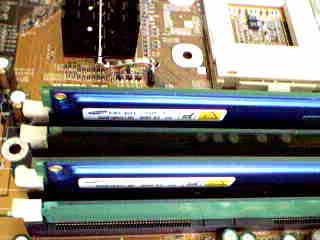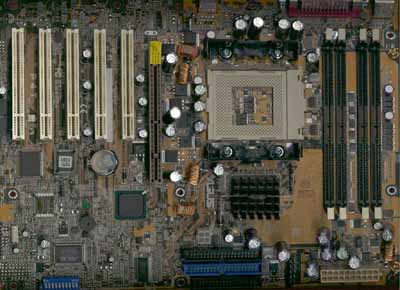Intel 850 Motherboard Roundup: September 2001
by Mike Andrawes on September 12, 2001 12:00 PM EST- Posted in
- Motherboards
ASUS P4T
|
ASUS P4T |
|
|
CPU
Interface
|
Socket-423
|
|
Chipset
|
Intel
850/ICH2
|
|
Form
Factor
|
ATX
2.03
|
|
Bus
Speeds
|
100 / 103 / 105 / 108 / 110 / 112 / 115 / 118 / 120 / 122 / 125 / 130 / 133 / 136 / 138 / 140 / 142 / 144 / 145 / 148 / 150 / 152 / 154 / 156 MHz |
|
Voltages
Supported
|
Auto
Detect |
|
Memory
Slots
|
4
184-pin RIMM Slots
|
|
Expansion
Slots
|
1
AGP Slot |
|
On-board
Audio
|
N/A
|
|
BIOS
|
Award
Medallion BIOS V6.0
|
Shortly after we received Intel’s own i850 board back in November 2000, ASUS sent us their i850 solution, the P4T. Sometimes it takes a manufacturer a few revisions to fully unleash a boards potential power, but not so with the P4T as it has turned out to be one of the best i850 boards out there.
The moment you open up box, you will notice a quite an impressive layout design, which is entirely different from Intel’s reference design. The major change is the location of the RIMM slots. Generally, the slots are located horizontally at the front of the board. On the P4T, they are located vertically, along the right edge of the board. While we don’t know for sure why ASUS has chosen this route, it could be to increase performance or stability.
Another interesting fact about the RIMM slots is the order in which you install the RDRAM. You will still need to install RIMMs in pairs, but instead of putting RIMMs together, you install the RIMMs and the CRIMMs (Continuity RIMMs) alternately. The only other i850 board we tested that uses the same memory arrangement is the ECS P4ITA.

The P4T, like many other ASUS boards, can be configured for jumperless or jumpered modes via a bank of 10 dip switches. Both modes give you control over the FSB speed and multiplier ratio. , although jumperless has a few additional FSB speeds. The P4T uses the Award Medallion BIOS and its clear that ASUS has put in quite a few tweaking options, especially with regards to memory. Like the ABIT TH7, the P4T allows you to manually select the memory speed, allowing you to force it to run asynchronously with the FSB - critical when you are trying to overlock to higher FSB speeds.

Interestingly enough, the P4T and the ABIT TH7 share almost the same set of FSB speeds as well. Although ASUS hasn’t implemented 1MHz increments either, the options available are sufficient to perform some serious overclocking already.
In the BIOS you can also find a small range of voltage tweaking options as well, allowing you to raise the CPU core voltage to enhance overclocking. Unfortunately, no I/O voltage tweaks were available that might help you overclock even further despite the fact that ASUS was one of the first to implement this back in the day. The P4T was able to achieve 145MHz during our overclocking tests, tying the ABIT TH7 as the most overclockable i850 board to date.
Another interesting aspect of the board is what ASUS did to get around the new ATX 2.03 format requirement. While some other manufacturers solve the problem by using plastic clips that attach to the motherboard instead of screws that attach to the case, ASUS has gone a completely different route. What they’ve done is add a baseboard that sits between the motherboard and your chassis, allowing the two HSF mounts to attach to the baseboard. It’s probably still a good idea to use an ATX 2.03 certified power supply, although our experience with the P4T did not require it.

Even though the P4T was one of the first few i850 boards to reach the AnandTech labs, it’s safe to say that it’s stood the test of time and is one of the best out there. The board offers lots of overclocking options and very good performance. The only downside is the lack of an on-board IDE RAID controller, a feature that has become quite common these days.











2 Comments
View All Comments
sabboo - Thursday, February 11, 2021 - link
This was the board in my first pc. As a student it was a very basic setup but got me through uni. I spent money on it and pushed the processor as far as it could go. I had upgraded the memory but it was beyond my financial means to do anything great at the time. Tomorrow I pull it out of the loft and see what I can buy to make this the ultimate gaming machine of its time. Any suggestions on pci cards to amke this an amazing addtion to my home network would be appreciated.infinitebritt - Thursday, March 25, 2021 - link
Amazing to see a comment about the D850GB in 2021. I use this motherboard TODAY for work. My work machine has not been plugged into the net since 2006. I have not installed or changed anything. It should run FOREVER. I made some money with crypto this year so I'm looking to spend $100-$200 to replace the ATX case with something smaller and quieter. The case I've been using for 15+ years is HUGE and LOUD